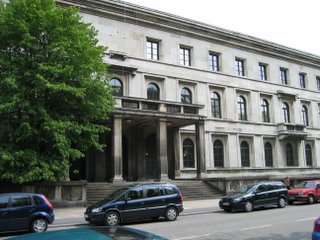Spielberg's Munich v. Goodman, Adams, And Sellars's Death Of Klinghoffer
... "[Steven] Spielberg is at his best in visualizing a world he believes to be more menacing than it has ever been. That is more than a matter of noirish shadows. It is the hint of suspicious movement in the back of the frame, a pan that goes on a few frames longer than necessary, suggesting the possibility of a menace that may be present. Near the movie's end, a casual pan along the Manhattan skyline reveals the World Trade Center buildings. Had to show them, the director says. They existed at a historical moment in the mid-'70s. But there is more than historical veracity at work in that shot. The Twin Towers are the symbols of our new age of high (and endless) anxiety. Maybe there is, as Spielberg insists, no resonance between the fate of the Towers' victims and the fate of a few athletes in long-ago, faraway Munich. But inevitably the destiny of those Towers tinctures our thoughts, however much we wish to deny them. Dutiful men like [Israeli Mossad lead agent]Avner Kauffman will be sent forth to improvise a response to terrorism, whatever its source. And to live with the unintended consequences of their actions. Any movie that subtly, yet insistently reminds us of this blunt truth about the world we have inherited is worth seeing. And pondering."
Richard Schickel "Spielberg Takes On Terror -
Munich adroitly blends high-pressure action and humanity in a historical story that's all about our times" Time Magazine December 12, 2005.
http://www.time.com/time/archive/preview/
0,10987,1137679,00.html

The "Führerbau" -- the Nazi Party Headquarters -- is now used by the Munich Music Conservatory.
"Georg Elser tried to kill Hitler with a bomb on November 8th 1939. The bomb exploded in Munich in the Bürgerbräukeller, the place where the "Beerhall Putsch" had been started from. Unfortunately Hitler had already left the building and was not injured at all.
Georg Elser was arrested and kept in Nazi concentration camps until April 9th, 1945. He was executed in the Dachau concentration camp on that day. On April 9th 2005, a play commemorating his death is shown in Berlin by Lou Favorite and Dietmar Elflein, see the website of the play."
http://www.ma224.de/
"Johann Georg Elser, a carpenter and worker in factories and quarries, had connections to several socialist and communist organisations, but did not act for them nor with their knowledge or support. He knew that the conditions for regular people were getting worse despite the Nazi Propaganda telling stories about growing wealth. Also, he knew from his work place that preparations for a war were being made, and that it would be inevitable unless Hitler himself were killed.
Taking advantage of the tools and materials he had access to, he built and carefully planted a bomb. It took one year of preparation, including a visit to the annual Nazi meeting the year before the attempt. He worked secretly for more than 30 nights inside the beer hall, hollowing the pillar near Hitler's traditional position to place a bomb with a self-made time ignition mechanism. The mechanism worked accurately and the explosion happened at 21:20. The ceiling came down and killed eight of Hitler's "old comrades" - but not Hitler himself, who had left early to catch a train back to Berlin, because fog over Berlin prevented an airplane flight. All other high-ranking Nazis left with him."
http://www.answers.com/topic/georg-elser
München im "Dritten Reich" - Pictures from Munich's dark past during the 'Third Reich'
http://mission.base.com/pictures/040515/muenchen-im-dritten-reich.html
Photo and first text credit: © 2005 by Tamiko Thiel and Peter Graf.
Richard Schickel "Spielberg Takes On Terror -
Munich adroitly blends high-pressure action and humanity in a historical story that's all about our times" Time Magazine December 12, 2005.
http://www.time.com/time/archive/preview/
0,10987,1137679,00.html

The "Führerbau" -- the Nazi Party Headquarters -- is now used by the Munich Music Conservatory.
"Georg Elser tried to kill Hitler with a bomb on November 8th 1939. The bomb exploded in Munich in the Bürgerbräukeller, the place where the "Beerhall Putsch" had been started from. Unfortunately Hitler had already left the building and was not injured at all.
Georg Elser was arrested and kept in Nazi concentration camps until April 9th, 1945. He was executed in the Dachau concentration camp on that day. On April 9th 2005, a play commemorating his death is shown in Berlin by Lou Favorite and Dietmar Elflein, see the website of the play."
http://www.ma224.de/
"Johann Georg Elser, a carpenter and worker in factories and quarries, had connections to several socialist and communist organisations, but did not act for them nor with their knowledge or support. He knew that the conditions for regular people were getting worse despite the Nazi Propaganda telling stories about growing wealth. Also, he knew from his work place that preparations for a war were being made, and that it would be inevitable unless Hitler himself were killed.
Taking advantage of the tools and materials he had access to, he built and carefully planted a bomb. It took one year of preparation, including a visit to the annual Nazi meeting the year before the attempt. He worked secretly for more than 30 nights inside the beer hall, hollowing the pillar near Hitler's traditional position to place a bomb with a self-made time ignition mechanism. The mechanism worked accurately and the explosion happened at 21:20. The ceiling came down and killed eight of Hitler's "old comrades" - but not Hitler himself, who had left early to catch a train back to Berlin, because fog over Berlin prevented an airplane flight. All other high-ranking Nazis left with him."
http://www.answers.com/topic/georg-elser
München im "Dritten Reich" - Pictures from Munich's dark past during the 'Third Reich'
http://mission.base.com/pictures/040515/muenchen-im-dritten-reich.html
Photo and first text credit: © 2005 by Tamiko Thiel and Peter Graf.


0 Comments:
Post a Comment
<< Home